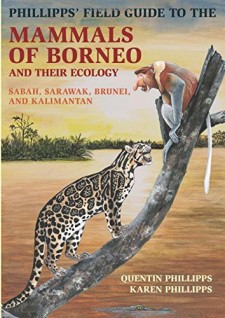Reviewed by Frank Lambert on June 27th, 2017.
Phillipps’ Field Guide to the Mammals of Borneo and Their Ecology: Sabah, Sarawak, Brunei, and Kalimantan is the most comprehensive, up-to-date, and portable field guide to the mammals of Borneo–the ideal travel companion for anyone visiting this incredible Sundaic island. Covering the East Malaysian states of Sabah and Sarawak, the tiny nation-state of Brunei, and the Indonesian part of Borneo (Kalimantan), the book provides essential information and beautiful illustrations of the 277 recognised species of land and marine mammals that occur here.
The Introduction, about 80 pages long, is an informative and profusely illustrated section that starts with a succinct account of the climate, followed by numerous short sections relating to the history, ecology, and plant life of Borneo in the context of its diverse assemblage of mammals. This assortment of short “illustrated essays” gives the reader a basis for understanding many of the marvellous ecological interactions that can be observed in almost any area of rain forest in Borneo. Subjects such as seed dispersal, seed predation, and an introduction to the most prominent families or groups of trees and other plants (such as Rafflesia) add immensely to the value of the book as a companion in the forest rather than just a field guide to the mammals.
The main section of the book is devoted to comprehensive species accounts for the 247 species of land mammal and 30 marine mammals that occur in and around Borneo and its satellite islands. Almost all of these species are illustrated by Karen Phillipps, many of the illustrations being those originally used in The Field Guide to the Mammals of Borneo, published in 1985 (Payne, Francis and Phillipps). Nine “cryptic” species that have only been recognised recently as a result of genetic studies are not illustrated, but there are very many new illustrations when compared to the 1985 field guide. There are also a scattering of high-quality photos of mammals accompanying selected species accounts. The number of mammals recognised in the region has increased rapidly in recent years as a result of taxonomic study, and this new book has made an effort to be up-to-date. Whereas, for example, the 1985 mammal guide included only one species of Slow Loris, there are now five included in this one. Similarly for Langurs (leaf monkeys) this new book recognises eight species where there were only five in the 1985 guide. The scientific nomenclature has also changed significantly.
Detailed facing-page species accounts start with size and status, and are organised under headings including ID and Habits and Range (called Distribution in a few cases). For better-known species there are other headings included, such as Call (e.g. Prevost’s Squirrel), Voice (Western Tarsier), Predators (Bornean Orangutan), Seed Dispersal (Long-tailed Macaque), and Captive Diet (Sunda Pangolin). This all makes for a rather random approach to the species accounts, but this does not really detract from the main purpose of the book, which is for identification in the field. Each species account also has a colour distribution map; in some cases (e.g. langurs) a larger map documents the range of the distinctive subspecies that occur on Borneo.
As with the introduction, the species accounts are full of snippets of interesting information, seemingly randomly inserted in some cases, but all make excellent reading. Some examples of these are “Civet Coffee”, “Giant Bees, Koompasia and Sun Bears”, “Relict Distribution of Rats and Treeshrews”, “John Whitehead and the Mammals of Kinabalu Park”, and “Scatter-hoarding by Three-striped Squirrels at Pasoh”. The final section of the book, about 60 pages long, provides a guide to where to see many of the mammals described in this book, concentrating mostly on the protected areas of the region. This section includes large-scale maps of sites and lists of species that occur there, as well as information on access and accommodation. Prominent bird species that occur in these areas are also often mentioned.
For anyone interested in the mammals of Borneo (or the Sunda region) or visiting the region to see wildlife, Phillipps’ Field Guide to the Mammals of Borneo and Their Ecology: Sabah, Sarawak, Brunei, and Kalimantan is an excellent book to take along, and will not only aid in the identification and appreciation of Borneo’s mammal’s but will also stimulate an interest in many ecological aspects of the region.
– Reviewed by Frank Lambert




Comment